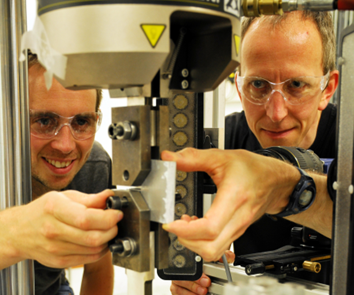- Diamond Light Source
- News & Literature
- Print Publications
- Diamond News
- Autumn 2015
- News
- Rig for high-force testing on I12
Keep up to date with the latest research and developments from Diamond. Sign up for news on our scientific output, facility updates and plans for the future.
See the impact of biaxial deformation on metals provided by BMW-MINI.Read On I12 shaping car design
Users wanting to study the effect of mechanical loading on large, high strength samples can now use I12’s servohydraulic mechanical test rig. The custom-designed uniaxial device has a capacity of 100 kN, and allows users to conduct in situ high force testing on materials such as steel, cast iron, titanium and superalloys. The rig has grips which can accept flat samples up to 15 mm thick or round samples up to 16 mm diameter. Adapters for M30 x 2 mm pitch right hand thread are also available.

Dr Chris Simpson (left), a Diamond user from the University of Manchester’s X-ray Imaging Facility based at the Research Complex at Harwell, loading a sample into the rig with I12’s Senior Beamline Scientist Dr Thomas Connolley.
In the past, portable low capacity rigs developed by users have been brought to the beamline regularly, and this continues to be an important part of the service offered on I12. The size of the new rig means it can cater for larger-scale samples or sample environments and can match the X-ray transmission of the high-energy X-rays available at the beamline. The rig is located in I12’s Experimental Hutch 2 and can be used with any of the beamline’s standard detectors for diffraction or imaging experiments. So far the rig has been used with I12’s unique 23 element energy-dispersive diffraction detector for a variety of in situ strain measurement experiments.
Dr Thomas Connolley, Senior Beamline Scientist on I12, led the project from design to installation and continues to gain user experience and feedback on the rig: "Since the first users came to study residual stress in a nickel-based superalloy, we’ve improved the functionality and performance to fit user needs." The beamline continues to retain its flexibility for users, as Dr Connolley explains: "The latest users on the beamline brought in their own camera system to measure surface strain with speckle patterns, while using energy-dispersive diffraction to map the strain field in loaded, notched steel specimens". These experiments are important for validating and improving crack growth and fracture models which are used to assess the damage tolerance of high performance structures like power station pressure vessels, offshore rigs or wind turbine towers.
The new rig complements the facilities available at the ISIS EnginX neutron scattering beamline, and gives users access to high force testing on a high energy X-ray beamline previously only available overseas. Users are encouraged to discuss their specific requirements with the beamline team when preparing beamtime applications.
For more information on the I12 beamline, or to discuss potential applications, contact Principal Beamline Scientist Dr Michael Drakopoulos: [email protected]
Diamond Light Source is the UK's national synchrotron science facility, located at the Harwell Science and Innovation Campus in Oxfordshire.
Copyright © 2022 Diamond Light Source
Diamond Light Source Ltd
Diamond House
Harwell Science & Innovation Campus
Didcot
Oxfordshire
OX11 0DE
Diamond Light Source® and the Diamond logo are registered trademarks of Diamond Light Source Ltd
Registered in England and Wales at Diamond House, Harwell Science and Innovation Campus, Didcot, Oxfordshire, OX11 0DE, United Kingdom. Company number: 4375679. VAT number: 287 461 957. Economic Operators Registration and Identification (EORI) number: GB287461957003.